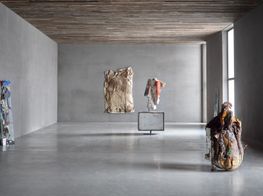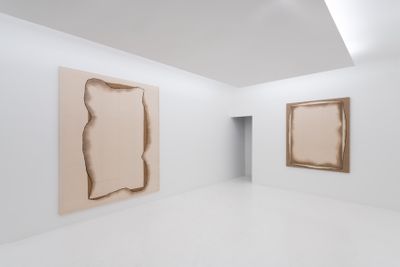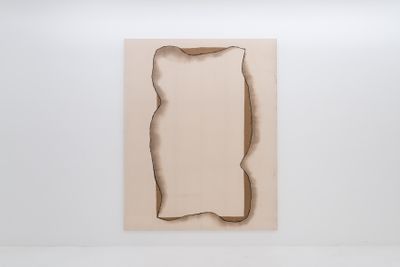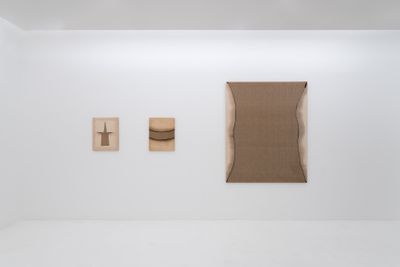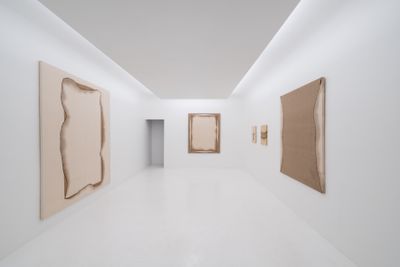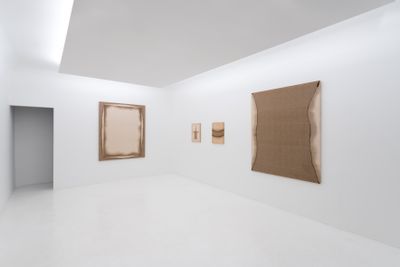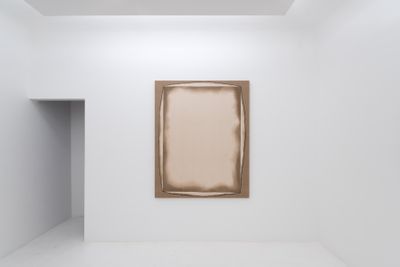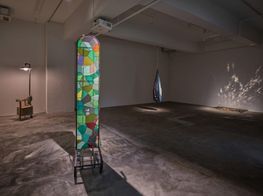Artist Insight: Tsuyoshi Maekawa
Tsuyoshi Maekawa's solo exhibition at Axel Vervoordt Gallery in Hong Kong (19 September–7 November 2017) brought together works the Japanese artist created in the late 1970s, a period that saw Maekawa shift dramatically from his earlier colour-based works to a minimalist practice that revolved around the use of oil painted hemp cloth and cotton in hues of brown.

Tsuyoshi Maekawa. Photo: Viktor Bentley.
The burlap objects manifest the core principles of Gutai Art Association, the Japanese post-war art group co-founded in 1954 by artists Shōzō Shimamoto and Jiro Yoshihara to 'express the idea that art constitutes the embodied, material manifestation of human spiritual freedom'. Early in his artistic career, Maekawa was drawn to the Gutai group's daring rejection of traditional artistic principles as they explored performance and installation art through physical action, making imprints of their bodies on flat paper or canvas. The group dissolved in 1972 after the death of Yoshihara.
In his youth, Maekawa was one of Japan's most notorious artists. His work has always been brave and rebellious, and encouraged by Yoshihara, he ripped, stuck, and painted so that the coarse, pliable burlap became an abstract but mutating exploration of disparate dimensions which gradually became more purified in their aesthetic as he matured. A leading member of the Gutai Art Association, which he joined in 1962, Maekawa was deeply affected by Yoshihara's sudden death, and was determined to achieve even greater originality and 'do his best on his own', as his mentor had advised him. Maekawa's time as a second generation Gutai artist was characterised by his blurring of the boundaries between painting and sculpture, attaching materials to burlap to create a completely new tactile medium, in a lighter, more refined style.
During the late 1960s Maekawa established M Design Studio but found the design work that supported him during these years prevented him from creating his own art. In 1974 he set up a studio at home, stopped working as a designer the following year, and supported himself by giving painting lessons to children. Because he had nowhere to store his larger works, many have been lost, but Maekawa is still mentioned in the same breath as the names of avant-garde artists such as Burri, Fontana, Pollock and Miró.
Have you always wished to reject representational art? Do you see art as physical matter rather than image?
I saw the end of the Second World War as an opportunity to create something altogether new and different from all art that came before it. I just wanted to find a way to create something that had never existed before. Separate from logic, a work is simply deemed either 'good' or 'bad'.
Has your understanding of 'flatness' in art changed over the years? Do you feel you have transcended its limitations?
It is not really something I am concerned with. Although it is 'flat', how I understand it has remained the same over the years. My understanding of texture also has not changed. I do not think there are limitations to 'flatness'. It is 'flat' if I create the work with the thought that it is 'flat'.
What led you to use burlap as your principal material? Has your relationship to it changed over the years?
I simply liked it because it was a familiar material. Over the years, I have come to like it more and more. But I have produced works with wool, synthetic fabric, leather, straw, rubber, and anything else that came to mind.
Do you agree when critics say that your work focuses on materiality and tangibility?
I agree with them for the most part.
Do you keep a diary or do all your words go into your art? Do you listen to music? What do you read?
Although I do not keep a diary, I make sketches and notes every day. I play Baroque and Classical music, as well as Latin American music, while making works. Recently, I have not had much time to read books.
When you were with the Gutai Art Association, did you feel that you were part of a pioneering group that aimed for 'the embodied, material manifestation of human spiritual freedom'?
They not only embodied spiritual freedom, but also believed that humans are free in every aspect. I think there is nothing as important as freedom.
How involved were you personally in the Expo '70 Gutai exhibition in Osaka in 1970?
I created a sculptural work displayed in the Midori Pavilion.
Despite your grief when Yoshihara died, did you also have a sense of liberation from the Gutai?
I had collected my thoughts, and told myself that from now on, I would do the best I could on my own and continue moving forward to new work.
When you established your own studio in 1974 were you more relieved at the freedom or frightened of the future?
It was during prosperous times, so I was terribly busy and had no time for painting.
Did teaching children open up a new trajectory for you?
Children are geniuses. They taught me all kinds of things, and I was even given hints and inspiration from them.
What interested you in making boxes?
I produced them when I participated in the exhibition 30 Cubic Centimeter Box in 1975 at Hakusan Gallery in Kobe and Gallery Doi in Himeji.
Do you work on more than one piece at a time?
Sometimes, I work on two or three pieces at a time.
After such a struggle, how did you feel towards the people who finally awarded prizes and recognition to you?
I feel very thankful for them.
Whose opinions do you respect as far as your own work is concerned?
My family's opinion; I believe they tell me the truth.
Do you feel that Westerners appreciate and understand your art in the same way as the Japanese?
Yes. There is no difference between the Westerners and the Japanese. I think that Westerners understand my work.
The Gutai movement's principle to break with anything that resembled the past was very much conceived in post-war Japan. Do you think its driving force remains relevant beyond that time period and its specific context?
I believe the spirit of Gutai is becoming more and more appreciated.
Do you find parallels between your work and that of Klee, Miró, Burri, and the American Abstract Expressionists whose works are often mentioned alongside yours?
There are parallels, as we are contemporaries.
Do you think that Gutai spirit is becoming better known on the international stage? If so, what do you think it will take for it to be recognised as important as other major art movements?
I believe Gutai will become recognised even more than other art movements.
Who are the artists you most respect, past and present?
Joan Miró.
Do you collect anything yourself?
I own original works and prints by my contemporaries.
Do you remain attached to your artworks? How did you feel when you found out panels from your quadriptych had been lost along with many of your larger works because you could not store them?
I had so many works that I had trouble finding space to safely store them, so I had thought that it couldn't be helped.
What was the inspiration for this exhibition in Hong Kong and what do you hope to achieve with it?
The inspiration for this exhibition is pureness of spirit, perhaps. The aim was to avoid doing anything unnecessary, and to closely examine free spirit and essence.
How does this exhibition fit in with your style as a whole?
I do not think that making works needs things like logic. If I can happily do whatever I like, then I think the works will give you the answers themselves, so I do not think of the works in terms of how they fit my style.
Can you explain what inspired the transition to working with burlap as a material?
I transitioned to working with burlap because I was drawn back to how fascinating it is still, in countless ways.
What does working with the material offer that oils and other media do not?
Because I can add some colour or wash out the colour, and devise various ways of wrinkling the fabric, I believe I can discover entirely new shapes and forms.
What part of the work excites you?
There is a size F-150 work on the left when entering the gallery, which I created by cutting out the centre, rotating it 180 degrees, then reattaching it. It was exciting that the work turned out more interesting than my initial expectations. —[O]

